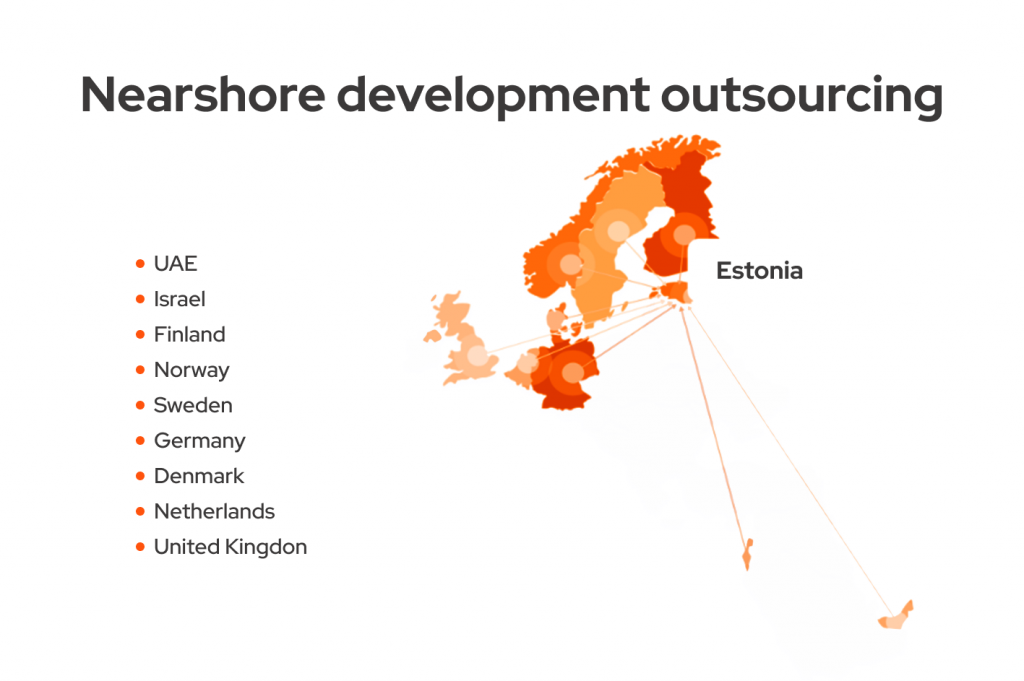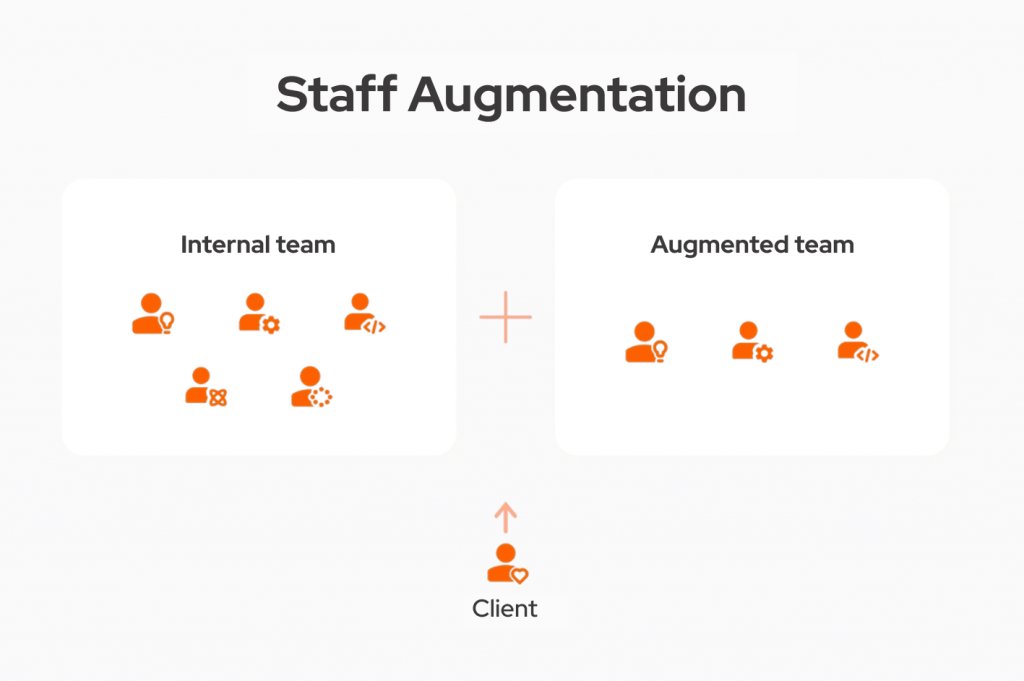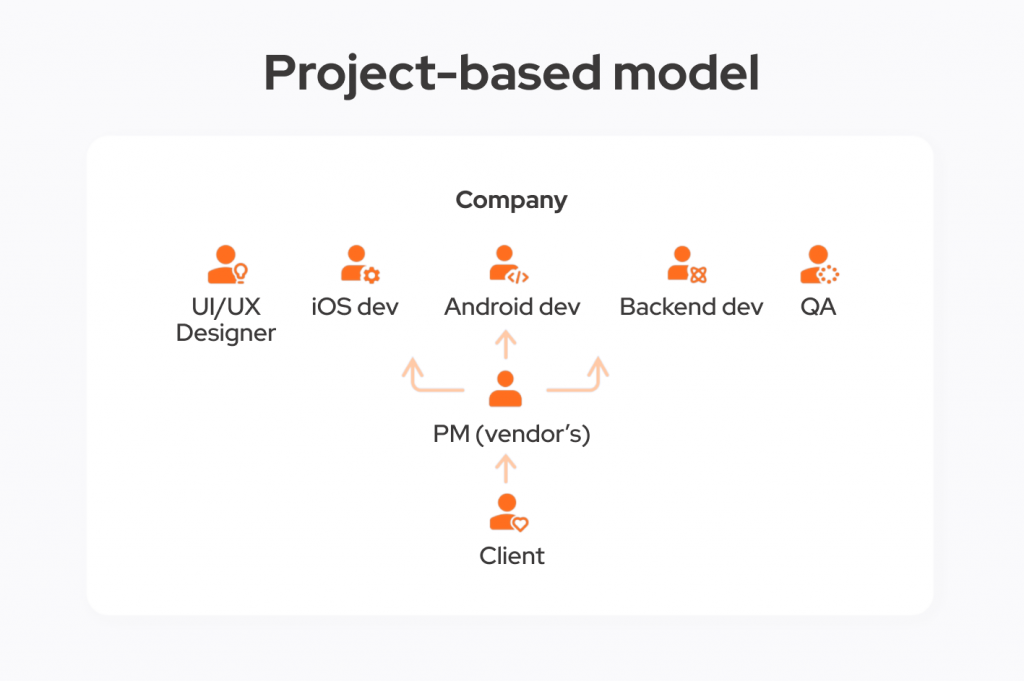Outsourcing is a common business strategy that allows companies to get staffing flexibility, lower costs, increase speed, and utilize advanced technology. Studies show that the global outsourcing market was valued at $245.9 billion in 2021 and is projected to grow at a rate of 9.1% annually from 2022 to 2030. However, with various outsourcing options available, it can be difficult for businesses to decide which model is the best fit for them.
This blog aims to give an overview of the most commonly used IT outsourcing models and assist you in identifying the one that will fulfill the specific needs of your business.
Types of IT Outsourcing Models – Onshore, Nearshore, and Offshore
The types of outsourcing models can be broadly classified into two categories: location-based and relationship-based.
Location-based outsourcing models are based on the geographical distance between the outsourcing team and the company. These models include:
Onshore Outsourcing – when the outsourced team is located within the same country as the company. The time zones and cultural differences are minimal, and communication is easy.

Nearshore Outsourcing – when the outsourced team is located in a neighboring country. The time zones may differ by a few hours, and communication may be more cost-effective than onshore outsourcing.

Offshore Outsourcing – when the outsourced team is located in a country that is farther away from the company. Offshore outsourcing can be more affordable, but communication can be more challenging due to language barriers and time zone differences.

The other category is Relationship-based IT Outsourcing Models, which are based on the nature of the relationship between the company and the outsourcing team. These models will be explained in detail in the guide. For more depth, read the guide to choosing an outsourcing partner in 2023.
Do not get confused between offshoring and onshoring. Offshore outsourcing and offshoring are two different concepts. Offshore outsourcing refers to the practice of delegating work to another entity in another country, while offshoring refers to the process of setting up a development team in another country. The key difference is that in offshoring, the company is responsible for building and managing the team, while in offshore outsourcing, the company hires a third-party vendor to manage the team on their behalf.
Relationship-Based IT Outsourcing Models
Staff Augmentation Model: If you need a specialist to improve one of your product’s more intricate features, it’s not necessary to go through a long hiring process for a temporary need. Instead, you can reach out to an outsourcing agency to get a professional expert to work with your team for the required time frame, this is called the staff augmentation model.

Dedicated Team Model: With a dedicated team model, you bring on a group of developers from an outsourcing agency to handle specific tasks that you don’t want to assign to your internal team. The outsourced team will handle their projects and won’t need to interact with your internal staff. Communication will be maintained through a project manager or similar role.

Project-based Model: If you opt for a project-centric approach to relationship-oriented outsourcing, you’ll only need to participate during the transition and delivery stages, not the project development phase.
This outsourcing model is typically the most favored one and is successful in cases where stakeholders are not actively involved. The major downside is that you will not have control over the project’s progression.
For successful communication, it is essential to establish the desired level of communication and the frequency of contact with the project manager assigned by the outsourcing provider.

Which outsourcing model is best suited for your business?
Taking into account the following factors will help you determine which outsourcing model is most appropriate for your business:
What are your project requirements?
To decide whether to outsource your project, you first need to understand your exact project requirements. When dealing with outsourcing and the development of your project, you should know the requirements like the back of your hand to avoid confusion.
Here are some questions to consider:
- At the end of the project, what do you hope to accomplish?
- What is the scope of your project?
- In your final product, what features would you like to see?
- Are your project milestones set?
- What timeline are you considering?
Once you have a better understanding of what your project needs, you can determine which type of outsourcing will be most effective for you. After identifying the appropriate method, it’s essential to assemble the appropriate team for the successful development of your product. This will also help prevent costly errors during the development process.
What type of pricing model do you wish to adopt?
There are two main pricing models in outsourcing: time and material and fixed price.
- Time and Material
The time and material pricing model is a popular billing method used in outsourcing. It involves the customer paying for the time spent on the project by the service provider’s employees, calculated at an agreed-upon hourly rate.
This pricing model is advantageous for customers as it allows them to only pay for the specific services they require. Additionally, service providers prefer this method as it guarantees a set amount of revenue for the project.
Pros:
- Flexibility: The T&M model allows for flexibility in the scope of work and makes it easier to accommodate changes during the project.
- Transparency: The T&M model allows for transparency in the costs of the project, as the client is only charged for the actual time and materials used.
- Adaptability: The T&M model allows for adaptability and accommodating to the changing needs of the project, which can be beneficial for complex or uncertain projects.
- Fair billing: The T&M model ensures that the client is only paying for the actual time and materials used, which can be more fair and transparent than other billing models.
Cons:
- Lack of budget predictability: The T&M model can make it difficult for the client to predict and control project costs, which can be a concern for budgeting and financial planning.
- Risk of overbilling: Without clear guidelines, a T&M model can lead to overbilling by the vendor, as the client is paying for all the time and materials used, regardless of whether they are necessary or not.
- Uncertainty of costs: The T&M model can make it difficult to predict the final cost of the project, which can be a concern for budgeting and financial planning.
- Scope creep: Without a fixed scope of work, the T&M model can lead to scope creep, where the scope of the project expands beyond the original agreement.
- Fixed-Price
The fixed-price model in IT outsourcing is a type of pricing where the customer and the vendor agree on a set cost for the entire project or a set of deliverables before the work begins. The advantage of this pricing model is that the customer knows in advance the total cost of the project, and this can provide budget certainty. On the other hand, the vendor knows in advance the revenue they will receive from the project and this can provide predictability.
This type of pricing is typically used for larger projects that have a well-defined scope and timeline.
Pros:
- Predictable costs: A fixed pricing model allows for predictable costs, which can be beneficial for budgeting and financial planning.
- Clear scope of work: With a fixed price, the scope of work is clearly defined and agreed upon by both parties, which can help to prevent scope creep and misunderstandings.
- Clear expectations: A fixed pricing model sets clear expectations for the client and the vendor, which can help to prevent misunderstandings and disputes.
- Aligns incentives: A fixed pricing model aligns the incentives of the vendor and the client, as both parties have a vested interest in completing the project on time and within budget.
Cons:
- Limited flexibility: A fixed pricing model can limit flexibility and the ability to make changes to the scope of work during the project.
- Risk of cost overruns: If the scope of work changes or unexpected issues arise, the fixed price may not cover the additional costs, resulting in cost overruns.
- Limited flexibility: A fixed pricing model can limit flexibility and the ability to make changes to the scope of work during the project
- Risk of under- or over-valuation: The fixed price may not accurately reflect the actual value or cost of the project, which could result in the vendor undercharging or the client overpaying.
What is your outsourced project’s dependency on the core team?
Managing a software development project is a complex task that requires the coordination and cooperation of multiple teams. To ensure that everyone is working towards the same goal, it is essential to establish clear lines of communication and cooperation between all team members.
When outsourcing a project, it is important to consider the level of dependency between your core team and your outsourcing partner. If your core team is heavily involved in the development process, it is important to ensure that work hours align and to avoid offshore outsourcing, as different time zones can make coordination difficult. On the other hand, if your core team is only responsible for tracking progress, you have more flexibility in choosing an outsourcing partner.
By clearly defining the role of your core team in the project, you will be able to better understand what type of outsourcing model will best suit the needs of your project.
What kind of relationship do you want with your outsourcing entity?
It’s important to determine the level of interaction you want with your outsourcing entity, as this will help to ensure a successful partnership. The type of relationship you choose will also play a role in determining the most appropriate type of outsourcing for your project management. For example, if you prefer to assign a project and wait until completion before checking in, a transactional relationship may be more suitable.
On the other hand, if you want to be closely involved in the development process, a strategic partnership may be a better fit. It’s important to keep in mind that outsourcing entities place a high value on customer service and client satisfaction, so the relationship you establish with them can have a significant impact on the success of your project.
Conclusion
It is easy to find reliable IT outsourcing service providers like Deqode, with access to a global talent pool for you to choose from.
To begin with, you need to understand the outsourcing type most beneficial to your business objectives. When you settle on the IT outsourcing services that you think will help your business succeed, contact us and we will take over from there!
Are you looking for a dependable tech ally to accompany you on your product journey, right from the beginning up until completion?
Great! When do you want to start working with us? Let’s Talk!
FAQs
How do I choose the right outsourcing model for my business?
To determine the best outsourcing model for your business, it is important to assess your specific needs and match them with the strengths of each model available. For example, a one-time project may be best suited for a project-based model, while ongoing assistance with a specific task or function may be better served by a managed services model. Additionally, if additional staff is needed to support your workload, a staff augmentation model may be the best fit.
What is an outsourcing strategy?
An outsourcing strategy is a plan that outlines how a company will utilize outsourced labor and services to achieve its goals. This plan should take into account the company’s needs, the capabilities of potential service providers, and any risks involved with outsourcing.
What are the risks associated with outsourcing?
Outsourcing can come with risks such as losing control of core functions or encountering quality control issues. Additionally, there is always the possibility of the service provider going out of business or the relationship not working out. It is crucial to thoroughly evaluate these risks before outsourcing any aspect of your business.
How can I find a reliable outsourcing partner?
When searching for an outsourcing partner, it is important to consider factors such as their reputation, ability to meet your needs, and the cost of their services. It is also essential to have a clear understanding of the terms of the agreement and to have a comfortable communication and reporting plan in place.
How can I effectively manage an outsourcing project?
Effective management of an outsourcing project involves clearly defining the scope of the project and the expectations for all parties involved. Additionally, having a communication and conflict resolution plan in place before any issues arise is essential. Regular monitoring of the project’s progress and ensuring all parties stay on track are also important elements of successful project management.




